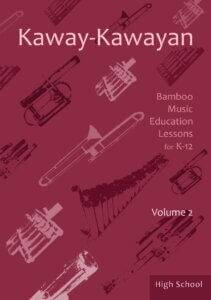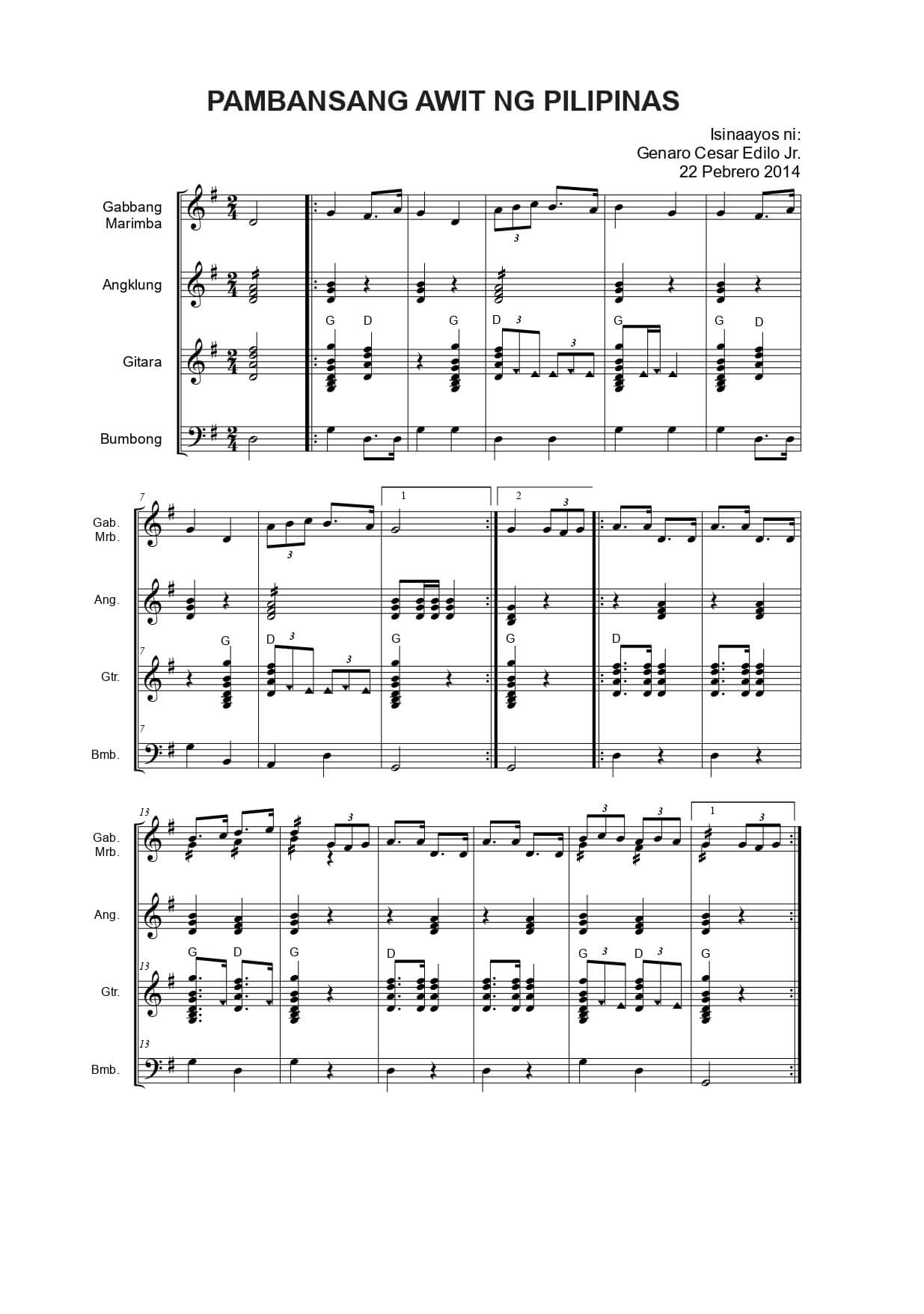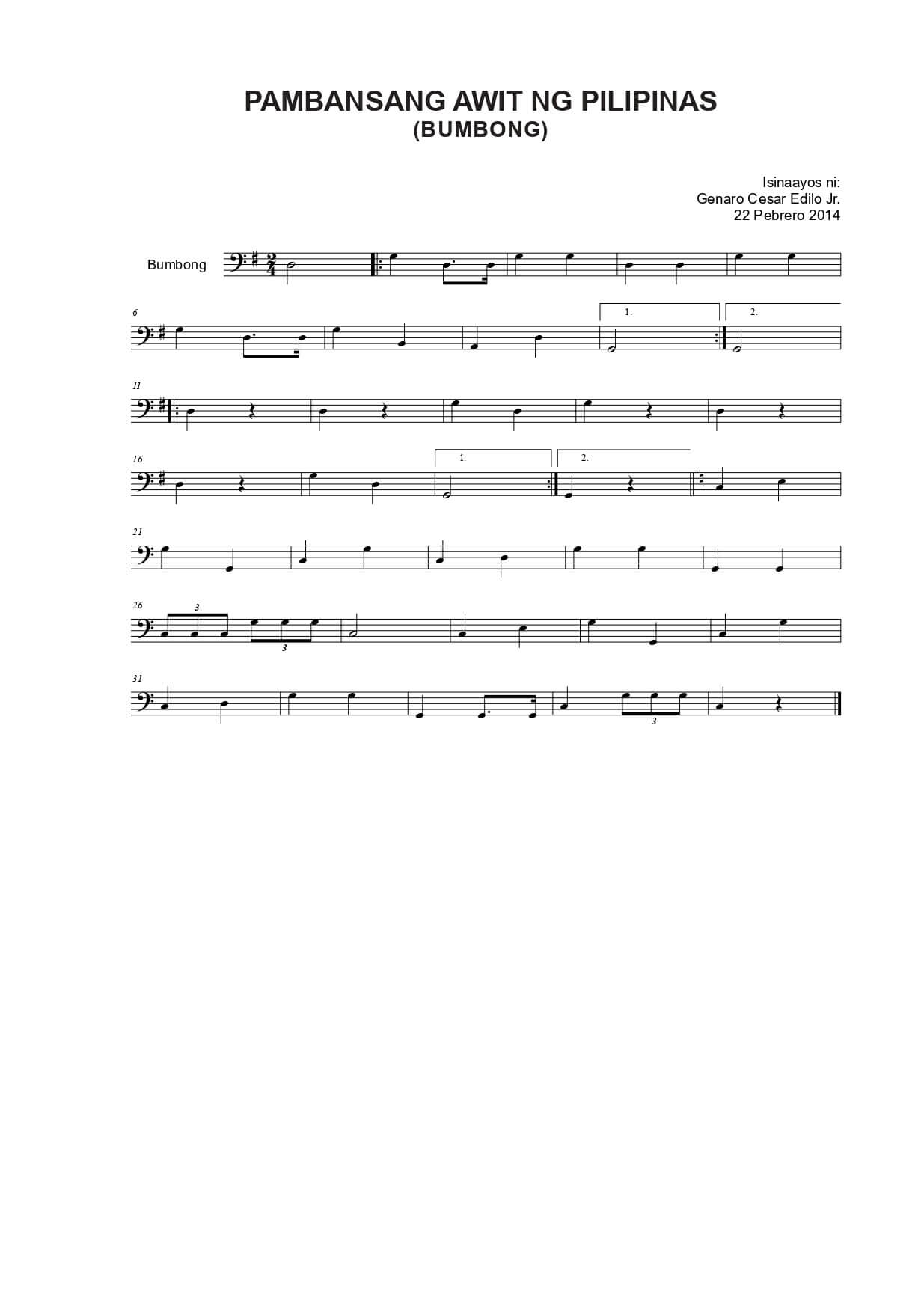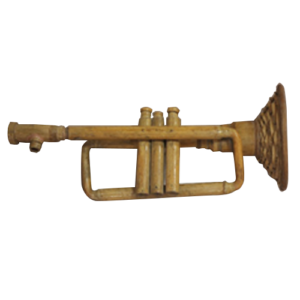Highschool Module
PAMBANSANG AWIT NG PILIPINAS REHEARSAL PLAN
Background
Composer: Julian Felipe
Lyrics: Jose Palma
Date: 1898
Arranger: Genaro Cesar Edilo Jr.

Lyrics
LUPANG HINIRANG
A
Bayang magiliw, Perlas ng silanganan, Alab ng puso, Sa dibdib mo’y buhay. Lupang hinirang, Duyan ka ng magiting, Sa manlulupig, ‘di ka pasisiil.
B
Sa dagat at bundok, sa simoy at sa langit mong bughaw, May dilag ang tula at awit sa paglayang minamahal.
Ang kislap ng watawat mo’y tagumpay na nagniningning.
Ang bituin at araw niya kailan pa ma’y di magdidilim.
C
Lupa ng araw, ng luwalhati’t pagsinta, Buhay ay langit sa piling mo.
Aming ligaya na ‘pag may mang-aapi, Ang mamatay nang dahil sa iyo.
“Lupang Hinirang,” (Tagalog, “Chosen Land”) or “Pambansang Awit ng Pilipinas” (Philippine National Anthem) was originally in Spanish known as “Marcha Nacional Filipina,” a march set composed by Julián Felipe in 1898. “Lupang Hinirang” began as an incidental music (background music), adapted as the anthem which President Emilio Aguinaldo commissioned for use in the proclamation of Philippine independence from Spain. It was first performed in public on June 12, 1898 on the balcony of his residence in Kawit, Cavite. General Emilio Aguinaldo proclaimed Asia’s first independent republic before a cheering throng, where the Philippine flag brought from Hong Kong was unfurled for the first time at the historic window of the Aguinaldo Mansion. The Banda San Francisco de Malabon (now called the Banda Matanda from present-day General Trias) played the “Marcha Nacional Filipina” during the proclamation of Philippines as a republic.
For more than a year, the Philippine National Anthem remained without any lyrics. In August 1899, Jose Palma authored the poem “Filipinas” in Spanish, which became the original words of the anthem. The poem was intended for publishing on the first anniversary of the La Independencia newspaper. Later, “Filipinas” was adapted to the music of “Marcha Nacional Filipina” (also known as “Himno Nacional Filipino”).
The lyrics of the Philippine National Anthem underwent several changes until its present version. Jose Palma’s original Spanish lyrics had been translated into English and Tagalog. During the American colonial rule of the Philippines, the Spanish lyrics of the anthem was translated into “The Philippine Hymn.” During the term of President Ramon Magsaysay, the Spanish lyrics of the anthem was translated into “Lupang Hinirang,” which became the official version of the Philippine National Anthem in 1956. The Surian ng Wikang Pambansa (Institute of National Language penned the current Tagalog lyrics and was adopted and made official subject to a slight revision in the 1960s. On February 12, 1998, Republic Act No. 8491 was passed, codifying the 1956 Tagalog lyrics into law abandoning the use of the Spanish and English versions.
Flag and Heraldic Code of the Philippines
Republic Act No. 8491 or The Flag and Heraldic Code of the Philippines regulates usage of the National Anthem and contains the complete lyrics of “Lupang Hinirang.” It cites that “The national anthem embodies and expresses the aspirations, dreams, ideals, longings, commitment and determination, nationalism and patriotism, sentiment and spirit of the people.”
Enacted in 1998, it states that “Lupang Hinirang” when performed “shall always be sung in the national language” regardless of if performed inside or outside the Philippines and specifies that the singing must be done “with fervor.” Violation of the law is punishable by a fine and imprisonment.
The anthem is usually played during public gatherings in the Philippines or in foreign countries where the Filipino audience is sizable. The Flag and Heraldic Code of the Philippines also cites that it be played at other occasions as may be allowed by the National Historical Institute (now known as the National Historical Commission of the Philippines). It prohibits its playing or singing for mere recreation, amusement, or entertainment except during international competitions where the Philippines is the host or has a representative; local competitions; during the “sign-on” and “sign-off” of radio broadcasting and television stations in the country; and before the initial and last screening of films and before the opening of theater performances.
As stipulated in Section 37 of the Flag and Heraldic Code of the Philippines, “The rendition of the National Anthem, whether played or sung, shall be in accordance with the musical arrangement and composition of Julian Felipe.”
The National historical Institute (NHI) says that the proper time signature is or duple meter and tempo is MM100 (100 BPM –100 beats per minute) and that the anthem should last 53 seconds.
Furthermore, according to Section 38, the attending public shall sing the anthem whenever it is played at a public gathering. While doing so, the public shall stand at attention facing the Philippine flag as a sign of respect. The other provisions on the national anthem are detailed in Chapter II, Sections 35 to 39 of R.A. 8491.
The Code specifies penalties for violation of its provisions. Section 48 provides for public censure and cancellation of licenses and permits, Section 49 requires the Department of Education (DepEd) and the Commission on Higher Education (CHED) to ensure that all students commit the national anthem to memory, section 50 specifies penalties of fine or imprisonment for violations.
Several bills have been introduced to amend the Flag and Heraldic Code to highlight the importance of complying, abiding and conforming to the standard expression
MATERIALS

Audio tracks – Scan QR code on the right
Sheet music – Pamulinawen arrangement by Genaro Cesar Edilo Jr.
The Philippine National Anthem is in 2/4 time signature or in duple meter. There are two beats in a measure and the beat note (the note that gets one beat) is the quarter note. This piece is to be performed in 100 BPM (100 beats per minute) tempo and should last 53 seconds.
The composition is in ternary form. It has basically three parts namely A, B, and C. The first measure (measure 1) is the introduction, a D7 block chord (dominant chord to G) to be played by the ensemble. Music A starts from measure 2 to measure 9 (8 measures in all equivalent to one period [composed of 2 phrases
– 1st phrase, antecedent/question is from measure 2 to measure 5 and 2nd phrase, consequent/answer, is from measure 6 to measure 9]), then a repeat mark
Time (2 Hours Session) |
Piece |
Instrument |
Measure |
Objective |
Activity |
Assessment |
| 10
minutes |
Pambansang Awit ng Pilipinas | m 1–35 | Discuss the following:
a. historical background a. 1 composer a. 2 lyricist a. 3 date of creation |
Lecture/ Demonstration
Interactive Discussion |
Class Recitation | |
| b. laws/ governing its performance | ||||||
| c. music analysis
c.1 time signature c.2 tempo c.3 form |
||||||
| 5 minutes | Discuss the | Lecture/ | Members | |||
| conducting | Demonstration | execute | ||||
| gestures for the | the correct | |||||
| piece: | conducting | |||||
| gestures for 2/4 time signature.
|
||||||
| 5 minutes | gabbang/ marimba angklung guitar bumbong | m – 1
1st time m 2 – 9
2nd time m 2 – 8 –10 (skip m 9) |
Analyze and discuss the following:
a. Introduction b. Music A b.1 key b.2 form phrase period section b.3 arrangement |
Lecture/ Demonstration
Interactive Discussion |
Recitation |
Science in a creative industry.
The DOST-FPRDI has a Bamboo Musical Instruments Innovation R&D program aimed at improving the quality of locally-made bamboo musical instruments (BMIs) through science and innovative technologies. The program seeks to standardize the production of selected BMIs, develop prototype designs, analyze raw material sources and existing markets, and build a BMI processing facility. In addition, the program aims to document the ethnocultural story behind several BMIs and identify the bamboo species used in BMI production to promote public awareness and appreciation of the cultural importance of these musical instruments. The program is a collaboration with the University of the Philippines and Philippine Normal University for teaching modules and analyzing sound quality and standardization of BMI design. The DOST Grants-in-Aid program provides funding.
PhBMI








